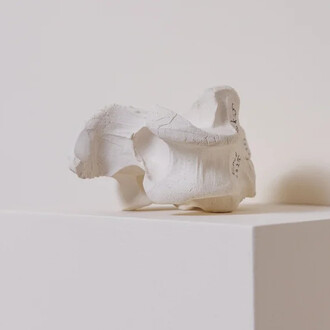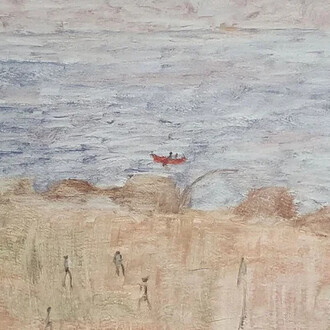Carol Rama: The tongue, the eye, the foot explores the human figure and its complex, psychological associations in the work of the celebrated Italian artist. Carol Rama (1918–2015) created art for over seventy years, producing disparate bodies of work that reflect the turns of her own life and that of the zeitgeist. This focused exhibition centers on a singular theme: the fragmented body as a site of fantasy and resistance in Rama’s work from the 1930s to the 1970s. The show examines eroticism as an expressive throughline that pierces Rama’s practice in overt figurative scenes and abstract forms. While Rama’s work has been exhibited widely throughout Europe since her death, this presentation marks the artist’s first significant American museum exhibition since her ICA Boston exhibition carolrama, in 1998, and her New Museum retrospective, Antibodies, in 2017.
Rama was born as Italian fascism came to power, and her earliest pieces made under this regime are deeply radical, as they depict forbidden obscenities. Looking to her surroundings and life experiences, each era of making—from abstract and figurative painting to assemblage, clothing, and sculpture—represents her visceral mode of perception under changing social and political conditions. Self-taught and balanced on the periphery of the art world until the late 1970s, the artist brushes up against several key movements of the twentieth century, including Arte Povera, assemblage, and the Italian literary neo-avant-garde, although she evaded strict association with any one group.
Rama’s watercolors from the late 1930s and early 1940s depict lascivious scenes. Born to a bourgeois family that underwent drastic economic and psychological hardship, the artist reflected her ensuing personal tragedy through her art. Many of Rama’s figures from this period portray the institutionalized and mentally ill. In these compositions, sexuality is linked with disability and illness: women appear nude except for their shoes, tongues hanging from their mouths. Snakes emerge from exposed orifices and unspoken fantasies come alive. With these unrestrained erotic gestures, the artist renders the privacy of lust overt.
The abject reappears in her bricolage assemblages from the 1960s, in which splattered bodily fluids function as mark-making devices. In her works made during these years, Rama often incorporated prosthetic limbs, syringes, and other medical instruments. The bricolage pieces in this exhibition share a preoccupation with the eye, either singular or multiple, emerging in clusters. Collaging inanimate human-like forms, Rama constructs morbid, almost hallucinatory monsters that mirror the global political tumult witnessed in the mid-twentieth century. Her creatures meet the viewer’s gaze, and peer back with unnerving alertness and desire.
In this gallery, Rama’s human forms—in whole, abstract, and formless incarnations—take shape as individual entities but impart a deeper sense of collective disobedience. Strange and often psychosexual, they foreground a sense of the forbidden, recalling sublimated truths and recessed memories. The fetishized and fragmented figure becomes more than a sum of its parts. Here, it becomes a lens to examine Rama’s radical depictions of the transgression, madness, joy, and defiance that defined her world.












